The AR Tour Services Market is expected to record a valuation of USD 2,450.6 million in 2025 and USD 9,380.5 million in 2035, with an increase of USD 6,929.9 million, which equals a growth of 283% over the decade. The overall expansion represents a CAGR of 14.4% and a 3.8X increase in market size.
During the first five-year period from 2025 to 2030, the market increases from USD 2,450.6 million to USD 4,794.6 million, adding USD 2,344 million, which accounts for 33.8% of the total decade growth. This phase records steady adoption in museums, city walking tours, and early theme park integrations, driven by the need for immersive visitor experiences. Smartphone/tablet-based AR solutions dominate this period as they cater to over 70% of delivery devices used across user groups such as tourists, local explorers, and students.
The second half from 2030 to 2035 contributes USD 4,585.9 million, equal to 66.2% of total growth, as the market jumps from USD 4,794.6 million to USD 9,380.5 million. This acceleration is powered by widespread deployment of AI-personalized tour guides, spatially-aware AR integrations, and subscription-based AR travel platforms. Smart glasses and mid-range devices together capture a larger share above 35% by the end of the decade. Cloud-based content platforms and AR SaaS ecosystems add recurring revenue, increasing the software/service component share beyond 40% in total value.
From 2020 to 2024, the AR Tour Services Market experienced a strong build-up toward immersive tourism solutions, with growth accelerated by museum digitization projects, heritage preservation initiatives, and city walking tour apps. Adoption was driven by the accessibility of smartphones and tablets, which provided a cost-effective entry point for AR experiences. By 2025, the market is projected at USD 2,450.6 million, with a significant shift toward subscription-based and pay-per-tour pricing models.
Looking ahead, the revenue mix will evolve as AR smart glasses and cloud-based AR platforms grow to capture larger shares beyond 2025. Traditional AR app providers are facing rising competition from digital-first platforms offering AI-driven personalization, real-time translations, and AR-integrated tourism packages. Market leaders are pivoting toward ecosystem-based models, combining devices, apps, and subscription passes to retain long-term customer engagement. Emerging entrants focusing on cross-sector applications in education, entertainment, and cultural preservation are also gaining traction.
The competitive edge is shifting away from AR delivery devices alone toward scalable platforms, immersive content libraries, and recurring revenue streams that power the next generation of tourism and cultural experiences.
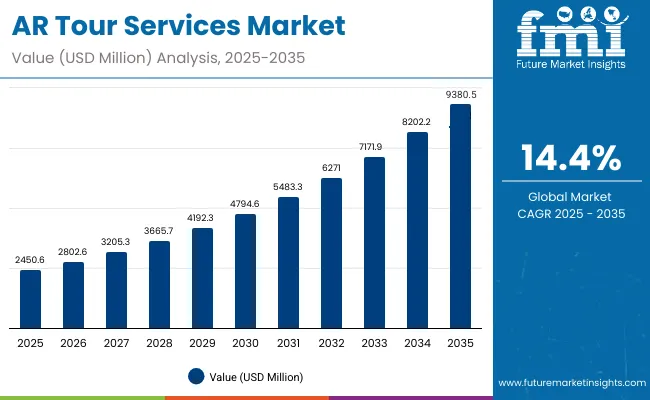
AR Tour Services Market Key Takeaways
| Metric | Value |
| Market Estimated Value in (2025E) | USD 2,450.6 million |
| Market Forecast Value in (2035F) | USD 9,380.5 million |
| Forecast CAGR (2025 to 2035) | 14.4% |
A major driver of AR Tour Services growth is its integration with museum digitization, cultural heritage preservation, and educational tourism. Governments and cultural organizations are funding projects that use AR to recreate historical environments, display 3D artifacts, and provide interactive storytelling. This not only improves visitor engagement but also helps in preserving fragile sites by reducing physical interaction. The use of AR in schools and universities for field trips and curriculum-based experiences is creating a long-term, sustainable adoption pipeline.
The market is accelerating due to the rise of AR smart glasses and their ability to deliver hands-free, location-based, and real-time multilingual tours. Tourists in foreign countries benefit from instant AR translations, AI-driven narration, and immersive overlays of cultural or historical insights. This personalized experience enhances convenience and accessibility, making AR indispensable for international travelers. As smart glasses become more affordable and integrated with cloud-based AR platforms, the market is seeing adoption beyond tourists, into students and local explorers, broadening its revenue base.
The market is segmented by application, delivery device, user group, pricing model, and region. Applications include museums & heritage, city walking tours, theme parks & attractions, and travel agencies/DMCs, highlighting the diverse areas where AR enhances visitor engagement and cultural experiences. Delivery device classification covers smartphone/tablet AR and AR smart glasses, catering to both mass-market accessibility and emerging immersive technologies.
Based on user groups, the segmentation includes tourists, students, and local explorers, reflecting the broadening appeal of AR services across different demographics. In terms of pricing models, categories encompass pay-per-tour and subscription passes, offering flexibility between one-time tourist demand and recurring usage by frequent visitors. Regionally, the scope spans North America, Europe, Asia-Pacific, and the Rest of the World, with high-growth opportunities in Asia-Pacific markets such as China, India, and Japan, steady adoption in Europe through Germany and the UK, and innovation-driven expansion in North America, led by the USA

| Delivery Device | Value Share% 2025 |
|---|---|
| Smartphone/tablet AR | 70.3% |
| Others | 29.7% |
The smartphone/tablet AR segment is projected to contribute 70.3% of the AR Tour Services Market revenue in 2025, maintaining its dominance as the primary delivery device. This leadership is driven by the ubiquity of smartphones and the accessibility of AR apps through existing mobile platforms, which lowers barriers to adoption for tourists and casual users. Smartphones enable location-based AR overlays, interactive storytelling, and real-time navigation, making them ideal for city walking tours, museums, and attractions.
Growth is also supported by the continuous improvement of mobile AR capabilities, including faster processors, high-resolution cameras, and 5G connectivity. These advancements enhance immersive experiences while keeping costs manageable for end-users. While AR smart glasses are expected to gain traction in the long term, smartphones and tablets will remain the backbone of AR tour services through the next decade due to their scalability and global reach.
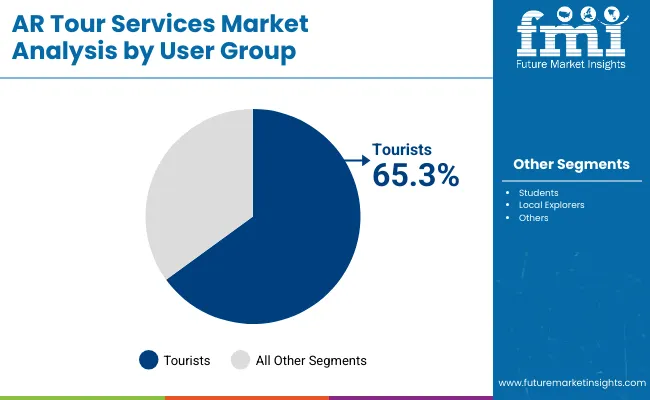
| User Group | Value Share% 2025 |
|---|---|
| Tourists | 65.3% |
| Others | 34.7% |
The tourist segment is forecasted to hold 65.3% of the AR Tour Services Market revenue in 2025, establishing itself as the leading user group. Tourists are the primary beneficiaries of immersive AR experiences, leveraging AR for city walking tours, museum visits, and heritage exploration. The demand is driven by the growing preference for interactive and personalized travel experiences that combine cultural storytelling with digital engagement.
Adoption is further supported by the global rise of experiential tourism, where AR enables travelers to visualize historical reconstructions, receive real-time multilingual narration, and enjoy gamified exploration of cities and attractions. As affordability improves and AR content libraries expand, tourists are expected to remain the dominant user base of AR tour services. Emerging groups such as students and local explorers will grow, but the tourist category will continue to anchor market revenues.
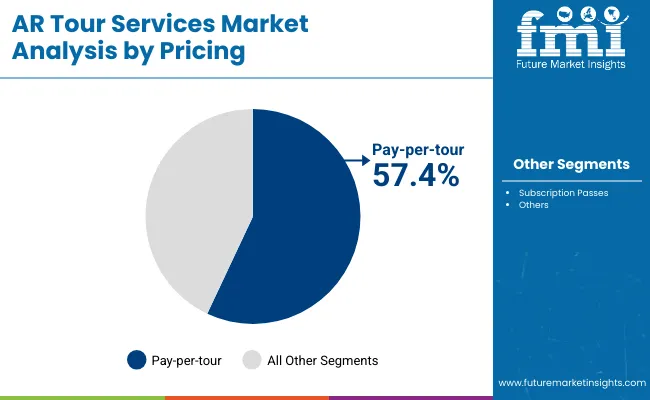
| Pricing | Value Share% 2025 |
|---|---|
| Pay-per-tour | 57.4% |
| Others | 42.6% |
The pay-per-tour segment is projected to contribute 57.4% of the AR Tour Services Market revenue in 2025, making it the leading pricing model. This dominance stems from the one-time, flexible nature of payments that aligns with tourist behavior, where visitors prefer paying for individual attractions, city walking tours, or museum experiences without long-term commitments.
Pay-per-tour is particularly effective for international travelers and casual users, as it provides access to AR-enhanced experiences without requiring subscriptions. Its success is also linked to bundled ticketing models, where museums, heritage sites, or travel agencies integrate AR into existing admission fees. While subscription passes are gaining traction among students and frequent local explorers, pay-per-tour will remain the anchor pricing strategy, given the large tourist base driving demand in the AR Tour Services Market.
Growing Demand for Immersive Cultural Experiences
A key driver of the AR Tour Services Market is the increasing consumer preference for immersive and interactive tourism. Museums, heritage sites, and city walking tours are deploying AR to overlay historical reconstructions, multilingual narration, and gamified exploration. This enhances visitor engagement while reducing reliance on physical guides. As international travel rebounds, tourists are actively seeking unique experiences that blend digital innovation with cultural authenticity, positioning AR as a vital tool for tourism boards, museums, and travel operators.
Accessibility Through Smartphones and Tablets
The dominance of smartphone/tablet AR delivery (70.3% in 2025) fuels market growth, as nearly every traveler already owns a compatible device. This eliminates the need for expensive hardware, allowing AR applications to scale quickly across regions and demographics. The widespread availability of 5G and high-resolution cameras further enhances real-time overlays and location-based interactivity. As AR apps integrate with booking platforms and navigation systems, the convenience of accessing AR tours directly from personal devices is accelerating adoption across both developed and emerging markets.
High Cost and Limited Adoption of AR Smart Glasses While smartphones drive mass adoption, the growth of AR smart glassesa critical step for hands-free immersive experiences is hindered by high costs, limited content libraries, and user hesitancy. For many travelers, investing in standalone AR glasses for short-term tourism is not viable. Content developers face challenges in scaling cross-platform experiences due to fragmentation. Until prices decline and ecosystems mature, reliance on smartphones will continue, slowing the full potential of immersive, real-time AR tour services.
Integration of AI and Cloud-based Personalization
A major trend in the AR Tour Services Market is the integration of AI-driven personalization and cloud connectivity. Platforms are increasingly offering real-time translation, adaptive storytelling, and behavior-based recommendations tailored to each user’s profile. Cloud-based AR ecosystems allow seamless updates and remote delivery of new experiences, ensuring scalability. This trend is particularly impactful for tourists in foreign countries, where personalized navigation, cultural narration, and interactive gamification create differentiated experiences. The convergence of AI, AR, and cloud platforms is reshaping digital tourism services globally.
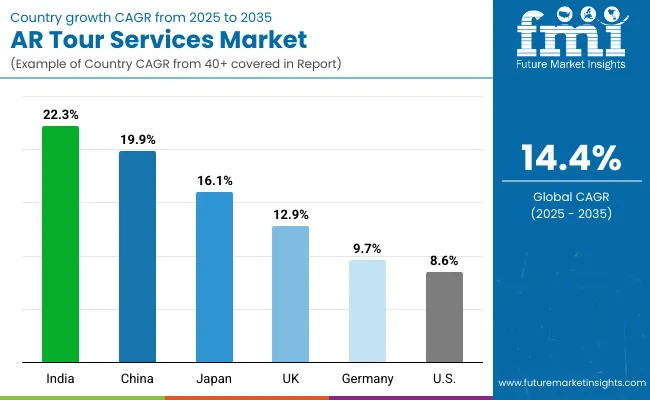
| Countries | Estimated CAGR (2025 to 2035) |
|---|---|
| China | 19.9% |
| USA | 8.6% |
| India | 22.3% |
| UK | 12.9% |
| Germany | 9.7% |
| Japan | 16.1% |
The global AR Tour Services Market shows distinct regional variations, shaped by cultural investment, smartphone penetration, and the pace of digital adoption in tourism. Asia-Pacific emerges as the fastest-growing region, anchored by India (22.3% CAGR) and China (19.9% CAGR). India’s growth reflects rising smartphone-led accessibility and government-backed initiatives for smart tourism and digital heritage preservation, which are expanding AR adoption in museums, monuments, and city tours. China’s momentum comes from strong support for cultural digitization, AI integration, and the rapid deployment of AR apps within domestic tourism ecosystems.
Europe maintains steady expansion, led by the UK (12.9% CAGR) and Germany (9.7% CAGR). Growth is supported by the region’s emphasis on museum digitization, heritage site preservation, and government-funded AR tourism programs. Demand in Europe also benefits from the integration of AR into theme parks and cultural institutions, making it a pioneer in public-private adoption models. Japan (16.1% CAGR) is another standout, with AR tour services expanding rapidly across city tourism, entertainment hubs, and educational institutions that emphasize immersive cultural experiences.
North America, with the USA at 8.6% CAGR, shows moderate growth due to a more mature digital tourism infrastructure. Growth is service-driven, fueled by AR-based museum exhibits, city exploration apps, and partnerships with travel agencies, but adoption is comparatively slower than Asia-Pacific where governments and cultural bodies are driving systemic digitization.

| Year | USA AR Tour Services Market (USD Million) |
|---|---|
| 2025 | 585.66 |
| 2026 | 661.95 |
| 2027 | 748.18 |
| 2028 | 845.64 |
| 2029 | 955.79 |
| 2030 | 1080.30 |
| 2031 | 1221.02 |
| 2032 | 1380.08 |
| 2033 | 1559.86 |
| 2034 | 1763.05 |
| 2035 | 1992.71 |
The AR Tour Services Market in the United States is projected to grow at a CAGR of 8.6% between 2025 and 2035, reaching nearly USD 2.0 billion by 2035. Growth is fueled by rising adoption of AR city walking tours, museum digitization, and interactive theme park attractions. USA cultural institutions are rapidly deploying AR apps to increase visitor engagement, expand accessibility, and integrate gamified learning experiences. The tourism sector is also seeing collaborations with start-ups and AR content developers to design more immersive experiences for both domestic and international travelers.
The AR Tour Services Market in the United Kingdom is expected to grow at a CAGR of 12.9% from 2025 to 2035, supported by strong adoption in museums, heritage sites, and cultural tourism. The UK has been at the forefront of digitizing artifacts and historical landmarks, enabling interactive storytelling and long-term digital preservation. Major cities are also integrating AR into walking tours and urban exploration, enhancing both domestic and inbound tourist experiences.
Beyond cultural applications, theme parks and attractions are deploying AR overlays to enrich visitor engagement through gamified entertainment. Educational institutions are incorporating AR-based city history tours and museum experiences into student programs, creating a broader base of recurring users. Government-backed innovation grants and collaborations between universities, cultural bodies, and private AR developers are fueling both enterprise and public-sector adoption.
India is witnessing rapid expansion in the AR Tour Services Market, forecast to grow at a 22.3% CAGR through 2035, the fastest among major economies. Growth is fueled by the digitization of museums, monuments, and cultural heritage sites, which are integrating AR overlays to bring history to life for visitors. Tier-2 and tier-3 cities are seeing rising adoption as affordable AR solutions and increased smartphone penetration enable broader accessibility beyond metro hubs.
The educational sector is playing a key role, with universities and training institutes deploying AR for interactive learning and virtual field trips, strengthening long-term adoption. Tourism boards and public infrastructure agencies are also investing in AR-based guides for national monuments and archaeological sites, creating immersive storytelling experiences for both domestic and international travelers. Private-sector initiatives from travel agencies and AR start-ups are complementing these efforts, expanding the user base to students, local explorers, and cultural tourists.
The AR Tour Services Market in China is expected to grow at a CAGR of 19.9% between 2025 and 2035, the highest among leading economies. This momentum is driven by the government’s strong focus on cultural digitization, smart tourism, and heritage preservation projects, which integrate AR into museums, historical landmarks, and urban attractions. Major cities are rolling out AR-enabled city walking tours, while theme parks and entertainment hubs are deploying immersive AR overlays to enhance visitor engagement.
Domestic AR technology firms are playing a crucial role by offering affordable, multilingual, and localized AR apps, enabling mass adoption across tourists and local explorers. Municipal governments are also encouraging the integration of AR into public tourism platforms, creating digital twins of heritage sites for global visibility. The educational sector further accelerates adoption, with AR used in history education, archaeology, and student field trips.
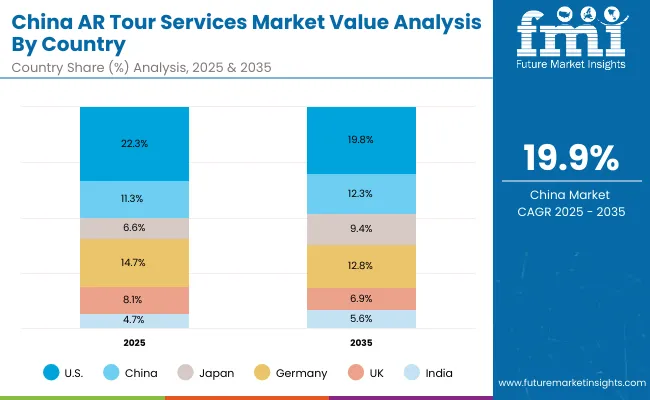
| Countries | 2025 Share (%) |
|---|---|
| USA | 22.3% |
| China | 11.3% |
| Japan | 6.6% |
| Germany | 14.7% |
| UK | 8.1% |
| India | 4.7% |
| Countries | 2035 Share (%) |
|---|---|
| USA | 19.8% |
| China | 12.3% |
| Japan | 9.4% |
| Germany | 12.8% |
| UK | 6.9% |
| India | 5.6% |
The AR Tour Services Market in China is expected to grow at a CAGR of 19.9% between 2025 and 2035, the highest among leading economies. Growth is propelled by the government’s strong commitment to cultural digitization, smart tourism, and heritage preservation projects, which are embedding AR experiences into museums, historical landmarks, and urban attractions. Major metropolitan areas are deploying AR-enabled city walking tours, while theme parks and entertainment hubs are integrating immersive AR overlays to enrich visitor engagement.
Domestic AR technology firms are a key growth driver, offering affordable, multilingual, and localized AR applications, ensuring adoption among both international tourists and local explorers. Municipal governments are also promoting AR integration into public tourism platforms, creating digital twins of heritage sites for enhanced global visibility. Additionally, AR adoption is accelerating in the education sector, where it is applied in history lessons, archaeology programs, and student field trips.
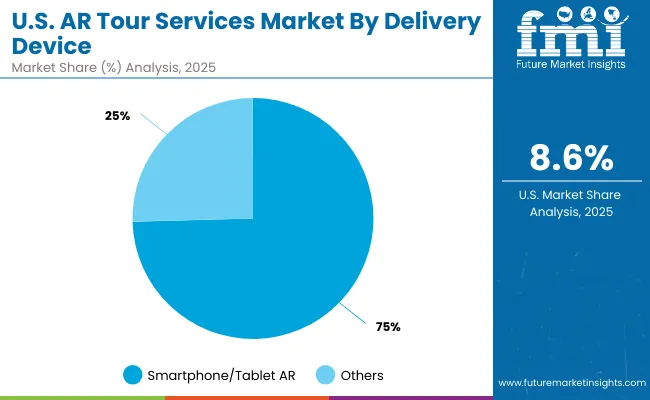
| USA by User Group | Value Share% 2025 |
|---|---|
| smartphone/tablet AR | 75% |
| Others | 25% |
The AR Tour Services Market in the United States is projected at USD 585.7 million in 2025, expanding at a CAGR of 8.6% through 2035 to reach nearly USD 2.0 billion. Growth is being driven by the rapid integration of AR into museums, cultural institutions, and city walking tours, alongside increased adoption in theme parks and entertainment venues. The USA is also at the forefront of AR platform innovation, with domestic start-ups and global leaders creating interactive cultural storytelling and tourism apps.
Unlike hardware-heavy markets, growth in the USA is being shaped by platform-driven services, where cloud integration and AI-powered personalization enhance the visitor journey. The market is also supported by subscription and bundled passes, increasingly offered by travel agencies and destination management companies (DMCs). By 2035, the USA will continue to hold a significant global share despite faster growth in Asia-Pacific, as its strength lies in content innovation, high tourist inflows, and a strong ecosystem of AR developers.
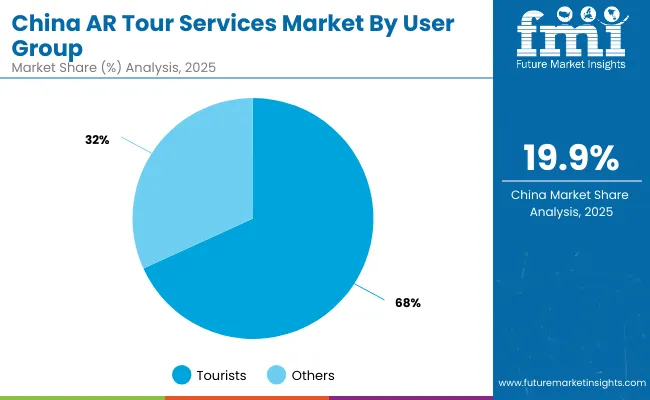
| China by User Group | Value Share% 2025 |
|---|---|
| Tourists | 68.2% |
| Others | 31.8% |
The AR Tour Services Market in China is valued at USD 276.9 million in 2025, making it one of the fastest-expanding markets globally with a 19.9% CAGR. The dominance of AR adoption in China is directly tied to the country’s cultural digitization programs, smart tourism projects, and urban AR walking tours, which are transforming how tourists and locals engage with history and entertainment. Domestic AR platforms are leading in multilingual capabilities, localized storytelling, and integration with super-app ecosystems, creating a distinct competitive advantage.
This positions China as a global leader in immersive tourism experiences, particularly through the rollout of AI-enhanced AR apps, cloud-based content distribution, and affordable smartphone/tablet AR solutions. While AR smart glasses adoption remains nascent, China’s ecosystem of low-cost device manufacturing is expected to accelerate uptake in the latter half of the forecast period. With government-backed innovation frameworks, China is poised to expand its global influence in AR-enabled tourism.
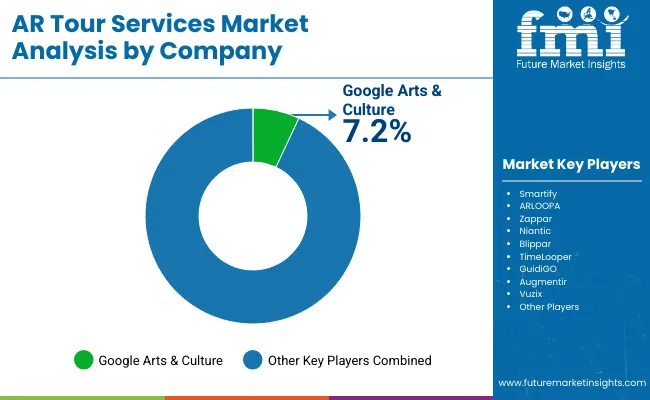
The AR (Augmented Reality) tour services market is expanding rapidly, driven by the increasing adoption of immersive experiences in tourism, museums, cultural sites, and historical attractions. Leading players in the market include Google Arts & Culture, Smartify, ARLOOPA, Zappar, Niantic, Blippar, TimeLooper, GuidiGO, and Vuzix Corporation, each offering unique AR solutions to enhance visitor engagement and provide interactive, educational experiences.
Google Arts & Culture leads the way with its global initiative to bring art, history, and cultural landmarks to life through AR, offering virtual tours and immersive experiences. Smartify provides museums with interactive AR-based services, allowing visitors to scan artworks and access rich, personalized content.
ARLOOPA and Zappar specialize in AR-based applications that overlay digital elements onto real-world objects, enhancing museum and tourism experiences. Niantic, known for its hit game Pokémon Go, extends its expertise to AR-based outdoor tours, gamifying sightseeing experiences.
Blippar focuses on interactive AR for advertising and cultural experiences, while TimeLooper offers immersive virtual reality and AR tours for historical events and landmarks. GuidiGO provides guided AR tours tailored to individual interests, often used in museums and galleries. Vuzix Corporation enhances the AR experience with smart glasses, enabling hands-free, immersive interaction.
| Item | Value |
|---|---|
| Quantitative Units | USD 2,450.6 Million |
| Application | Museums & heritage, City walking tours, Theme parks & attractions, Travel agencies & DMCs |
| Delivery Device | Smartphone/tablet AR, AR smart glasses |
| User Group | Tourists, Students, Local explorers |
| Pricing | Pay-per-tour, Subscription passes |
| Regions Covered | North America, Europe, Asia-Pacific, Latin America, Middle East & Africa |
| Country Covered | United States, Canada, Germany, France, United Kingdom, China, Japan, India, Brazil, South Africa |
| Key Companies Profiled |
Google Arts & Culture, Smartify, ARLOOPA, Zappar, Niantic, Blippar, TimeLooper, GuidiGO, Vuzix Corporation |
| Additional Attribut es | Dollar sales by delivery device and pricing model, adoption trends in museums, heritage sites, and city walking tours, rising demand for multilingual AR and AI-driven narration, sector-specific growth in theme parks, cultural institutions, and travel agencies, revenue segmentation by tourists, students, and local explorers, integration with AR/VR and digital twin technologies, regional trends influenced by smart tourism and cultural digitization initiatives, and innovations in wearable AR smart glasses and cloud-enabled AR platforms. |
The global AR Tour Services Market is estimated to be valued at USD 2,450.6 million in 2025.
The market size for the AR Tour Services Market is projected to reach USD 9,380.5 million by 2035.
The AR Tour Services Market is expected to grow at a 14.4% CAGR between 2025 and 2035.
The key delivery devices in the AR Tour Services Market are smartphone/tablet AR and AR smart glasses.
In terms of user groups, tourists are set to command 65.3% share in the AR Tour Services Market in 2025.






Our Research Products

The "Full Research Suite" delivers actionable market intel, deep dives on markets or technologies, so clients act faster, cut risk, and unlock growth.

The Leaderboard benchmarks and ranks top vendors, classifying them as Established Leaders, Leading Challengers, or Disruptors & Challengers.

Locates where complements amplify value and substitutes erode it, forecasting net impact by horizon

We deliver granular, decision-grade intel: market sizing, 5-year forecasts, pricing, adoption, usage, revenue, and operational KPIs—plus competitor tracking, regulation, and value chains—across 60 countries broadly.

Spot the shifts before they hit your P&L. We track inflection points, adoption curves, pricing moves, and ecosystem plays to show where demand is heading, why it is changing, and what to do next across high-growth markets and disruptive tech

Real-time reads of user behavior. We track shifting priorities, perceptions of today’s and next-gen services, and provider experience, then pace how fast tech moves from trial to adoption, blending buyer, consumer, and channel inputs with social signals (#WhySwitch, #UX).

Partner with our analyst team to build a custom report designed around your business priorities. From analysing market trends to assessing competitors or crafting bespoke datasets, we tailor insights to your needs.
Supplier Intelligence
Discovery & Profiling
Capacity & Footprint
Performance & Risk
Compliance & Governance
Commercial Readiness
Who Supplies Whom
Scorecards & Shortlists
Playbooks & Docs
Category Intelligence
Definition & Scope
Demand & Use Cases
Cost Drivers
Market Structure
Supply Chain Map
Trade & Policy
Operating Norms
Deliverables
Buyer Intelligence
Account Basics
Spend & Scope
Procurement Model
Vendor Requirements
Terms & Policies
Entry Strategy
Pain Points & Triggers
Outputs
Pricing Analysis
Benchmarks
Trends
Should-Cost
Indexation
Landed Cost
Commercial Terms
Deliverables
Brand Analysis
Positioning & Value Prop
Share & Presence
Customer Evidence
Go-to-Market
Digital & Reputation
Compliance & Trust
KPIs & Gaps
Outputs
Full Research Suite comprises of:
Market outlook & trends analysis
Interviews & case studies
Strategic recommendations
Vendor profiles & capabilities analysis
5-year forecasts
8 regions and 60+ country-level data splits
Market segment data splits
12 months of continuous data updates
DELIVERED AS:
PDF EXCEL ONLINE
North America Outbound Medical Tourism Services Market – Growth & Forecast 2022-2032
Art Tourism Market Analysis by, by Service Category, by End, by Booking Channel by Region Forecast: 2025 to 2035
Analyzing War Tourism Market Share & Industry Leaders
War Tourism Market Insights - Size, Trends & Forecast 2025 to 2035
Dark Tourism Market Forecast and Outlook 2025 to 2035
Tourism Market Trends – Growth & Forecast 2025 to 2035
Safari Tourism Market Size and Share Forecast Outlook 2025 to 2035
Safari Tourism in Africa Market Size and Share Forecast Outlook 2025 to 2035
AR Fitness Services Market Analysis - Size and Share Forecast Outlook 2025 to 2035
Genitourinary Prosthetics Market Size and Share Forecast Outlook 2025 to 2035
Culinary Tourism Market Analysis – Trends & Forecast 2024-2034
Literary Tourism Market Analysis – Trends & Forecast 2024-2034
The Car Detailing Services Market is segmented by service type and region from 2025 to 2035.
Competitive Overview of Geotourism Market Share
Geotourism Market Insights - Growth & Trends 2025 to 2035
Global Ecotourism Market Insights – Growth & Demand 2025–2035
Home Care Services Market Size, Growth, and Forecast 2025 to 2035
UK Safari Tourism Market Analysis – Growth, Demand & Forecast 2025-2035
Agritourism Market Size and Share Forecast Outlook 2025 to 2035
M2M Services Market Size and Share Forecast Outlook 2025 to 2035

Thank you!
You will receive an email from our Business Development Manager. Please be sure to check your SPAM/JUNK folder too.
Chat With
MaRIA